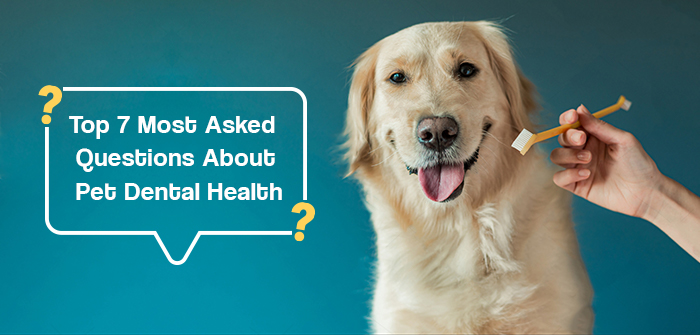The Top 7 Most Asked Questions About Pet Dental Health
Daily dental care for pets is significantly more than an aesthetic concern. Daily dental care is crucial protection against periodontal disease – the most common cause of bad breath in dogs and cats.
Periodontal disease, which is caused by plaque and tartar buildup, can result in tooth loss and oral diseases. Periodontal disease can also have a secondary effect on specific organs (such as the heart, kidneys, and liver), causing or exacerbating organ system disorders. According to surveys and research, more than 80% of dogs and 70% of cats have some sort of dental illness by the age of three.

Here are some of the most frequently asked questions regarding pet dental health that explain more about the importance of pet dental care to help pet owners with pet dental care and help pets avoid the risks of periodontal disease.
1 – What factors contribute to dental disease?
Plaque bacteria cause periodontal disease. Plaque is a sticky substance that builds on teeth after brushing or professional cleaning. Plaque is made up of regular mouth bacteria, saliva, and food particles. The oral bacteria initiate a cycle of inflammation that can be limited to the gingiva, or it can continue and cause major periodontal disease that travels down the tooth, causing bone loss and infection, both of which can have catastrophic local and systemic (body-wide) effects.
2 – What are the symptoms of dental disease?
Bad breath (halitosis), edema and redness of the gum tissue or other soft tissues in the mouth, drooling or excessive salivation are the most prevalent symptoms. Other symptoms include chewing trouble, discolored or broken teeth, loose or missing teeth, nasal discharge or sneezing, and swelling of the cheek, jaw, or neck.
3 – How do plaque and tartar differ?
Plaque is a bacterial colony that has been combined with saliva, blood cells, and other bacterial components. Plaque is frequently the cause of tooth and gum disease. Dental tartar, also known as calculus, forms when plaque mineralizes (hardens) and firmly attaches to the tooth enamel, eroding the gingival tissue.
4 – What is the impact of periodontal disease on my pet?
Periodontal disease can cause discomfort, gum infection, and tooth loss on a local (in the mouth) level. Chronic periodontal tissue infection permits bacteria to enter the bloodstream, seeding the internal organs (heart, kidneys, liver) and potentially leading to catastrophic infections in these organs.
5 – Is it necessary to brush my dog’s teeth regularly?
Brushing your pet’s teeth twice a day is recommended by a veterinary dentist. Most dog owners brush their dog’s teeth at least once each day, and some do it every few days, which is great. A minimum of three brushings each week is recommended to minimize plaque and tartar formation.
Brushing your dog’s teeth on a regular basis allows you to monitor the health of his mouth. Examine the area from the roof of the mouth to the area beneath the tongue. These surfaces should be kept wet and smooth at all times.
6 – My dog dislikes brushing teeth. What Should I Do?
Brushing your dog’s sparkling whites should ideally begin when he or she is a puppy. It may take a little longer for an adult dog to accept dental brushing, but it is well worth the time and effort! To successfully train your pet, you must make it a pleasurable experience for him or her.
Here are some tips to assist you to accomplish this huge task:
- Locate a location free of distractions.
- Place tiny dogs in your lap, facing away from you. If you have a large dog, place them on a chair next to you so you can comfortably hold its mouth.
- Gently rub your finger or a soft cloth over the outside surface of your dog’s teeth.
- Rub only a few teeth at a time during the first few sessions, rather than the entire mouth. This will make brushing teeth more comfortable for frightened pets.
- Apply pet toothpaste to your finger and give it to them to taste. When your dog is calm, apply some to a tiny cloth and rub it all over their teeth. You can do this until your pet is used to having his teeth rubbed.
- Once your dog is comfortable, you can begin using a special toothbrush. Apply a small bit on the toothbrush, and then gently elevate one side of your pet’s mouth. Brush one side for 30 seconds.
- Tilt your dog’s head backward while holding the top jaw with your thumb and index finger to wash their lower teeth.
Brush the cheek and canine teeth, which are areas where plaque collects quickly. It’s fine if you can’t brush the interior surfaces. The plaque is removed from that location by your dog’s tongue, and damage usually develops on the outside surface.
Brushing your dog’s teeth requires a lot of patience and days, even weeks of calming your dog down.
7 – What can happen if I don’t brush my pet’s teeth?
Plaque and tartar both harm the teeth and gums. The gums are the first to be affected by the disease (gingiva). They become inflamed, turning red, bloated, and painful. The gums eventually separate from the teeth, forming pockets where bacteria, plaque, and tartar can accumulate. These, in turn, cause further damage and, eventually, tooth and bone loss.
Read About: Most Common Dental Diseases in Dogs
The Last Word
Brush your dog’s pearly teeth at least three to five times each week to eliminate plaque and prevent tartar formation. Gingivitis, an inflammation of the gum line produced by plaque bacteria, is a common precursor to periodontal disease.
As a result, it is critical that your dog’s teeth are kept clean in between brushings. No other factors such as heavy pressurize brushing with two-headed toothbrushes in which your dog may feel it irritating and will not allow you to do his/her brushing easily.


